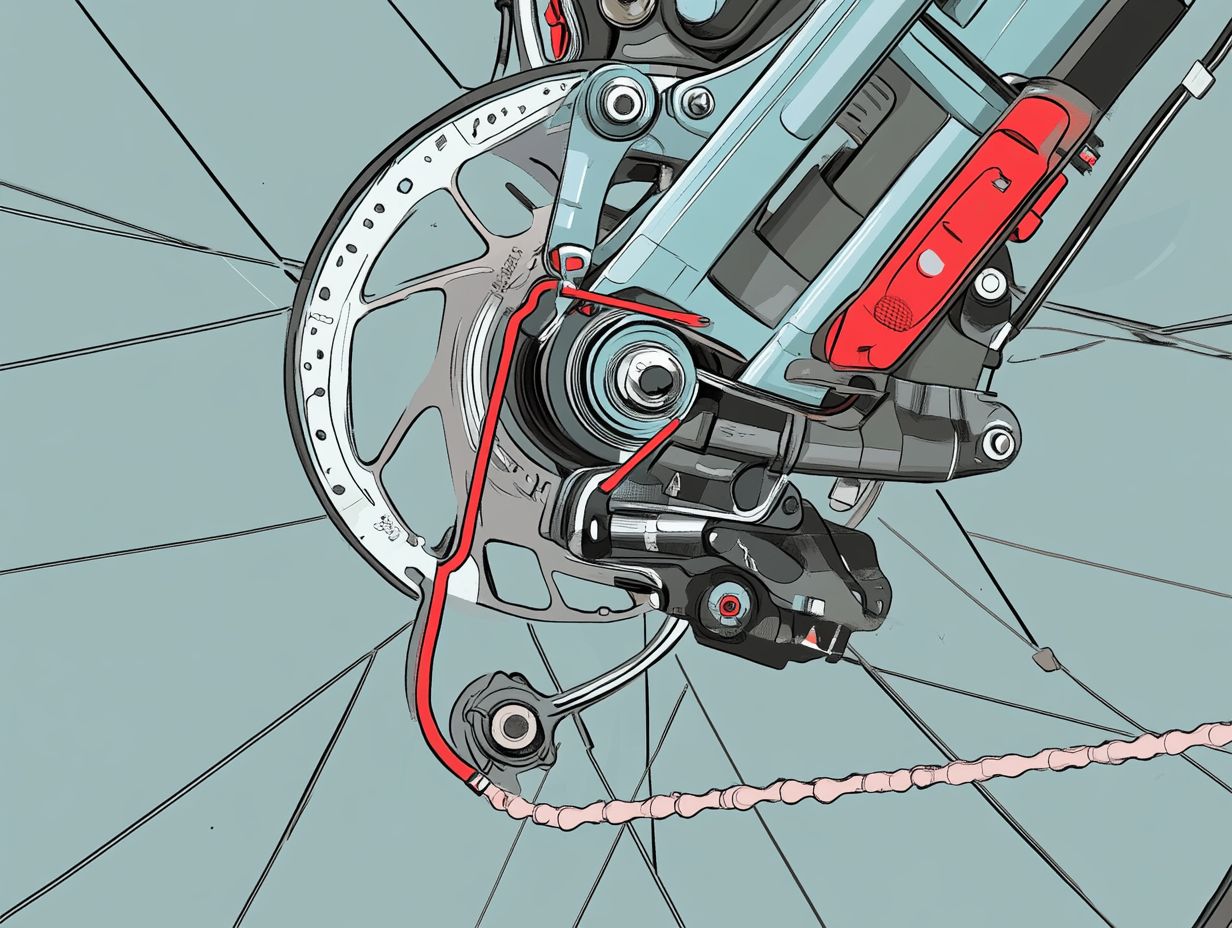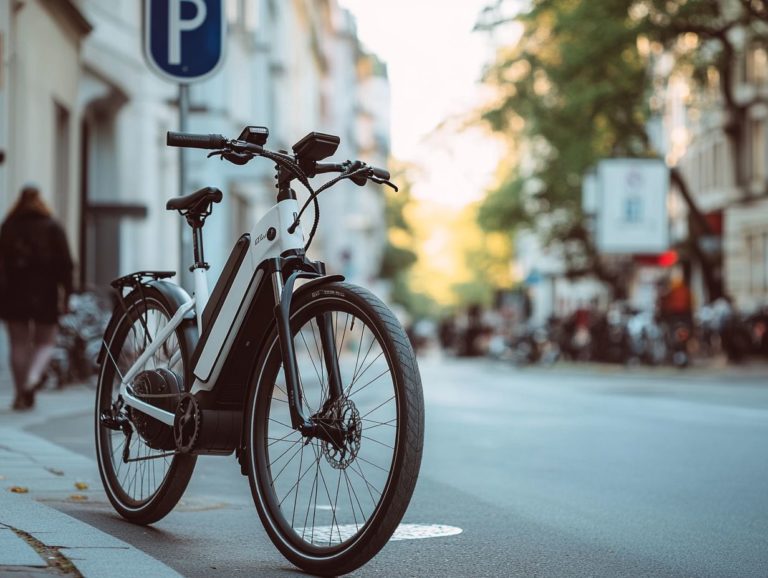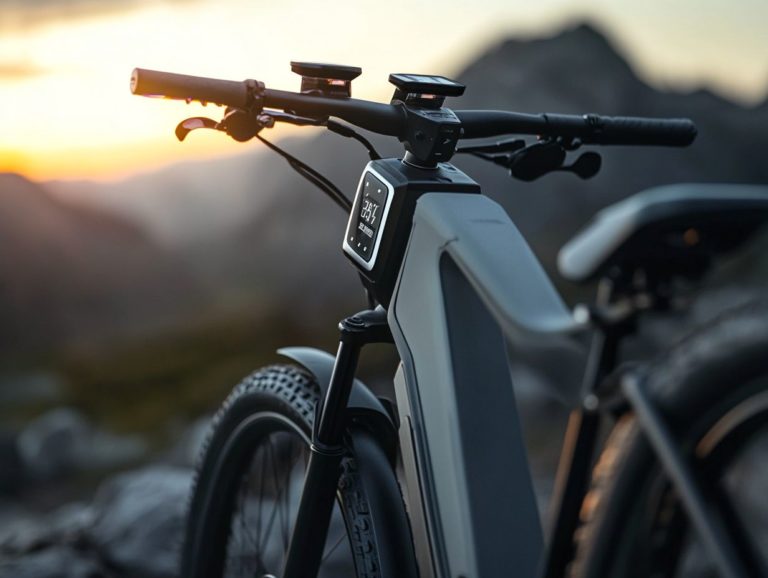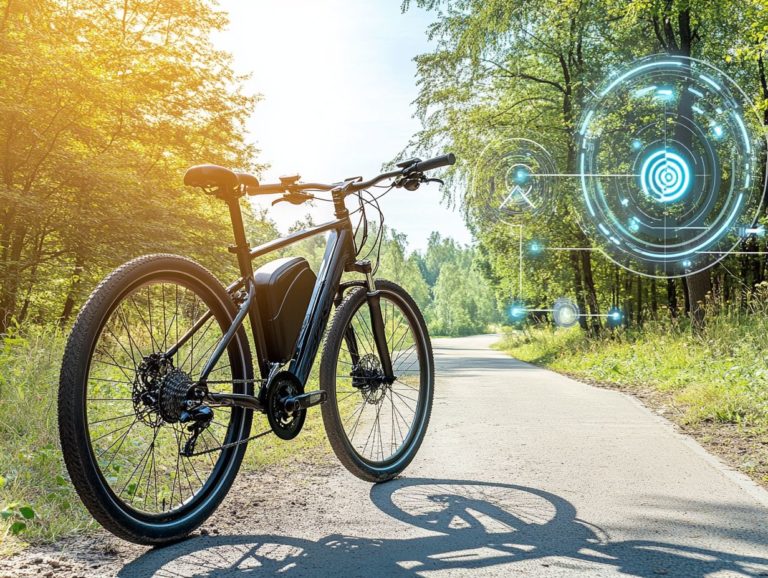How Do Electric Bicycle Brakes Work?
Electric bicycles and e-bikes are revolutionizing your cycling experience, seamlessly blending traditional mechanics with cutting-edge technology.
A crucial element that guarantees your ride is both safe and smooth is the braking system, which includes advanced features like a kill switch.
Explore the exciting world of electric bicycle brakes! This article examines the various types of brakes utilized in electric bicycles, including hydraulic disc brakes and mechanical disc brakes, exploring how they operate in contrast to traditional bicycle brakes while highlighting the distinct features that arise from the integration of motor and battery power.
You ll find essential tips for maintaining and servicing your electric bicycle brakes, including brake pad cleaning and understanding e-bike maintenance. Regular maintenance is vital for safe rides don t skip it!
Contents
Must-Know Facts About E-Bike Brakes:

- Electric bicycle brakes use either rim, disc, or drum types, each with their own pros and cons, including e-bike specific designs that cater to different needs.
- Traditional bicycle brakes work by using friction to slow down and stop the bike, while electric brakes utilize both mechanical and electronic components, including braking force management for greater control.
- Regular maintenance and proper care, such as checking brake rotor size and brake durability, are crucial for the smooth and safe functioning of electric bicycle brakes.
An Overview of Electric Bicycle Brakes
Electric bicycle brakes play a pivotal role in the safety and stopping power of your e-bike, especially in Class 3 models. With advancements in braking technology, including the development of regenerative braking, manufacturers have crafted a range of systems tailored to various riding styles and safety needs.
From hydraulic disc brakes, which use fluid pressure to operate and provide strong stopping power, like those from Tektro and SRAM, to mechanical options, your choice of braking system can profoundly influence your e-bike’s performance and safety. It s crucial for you, as an e-bike owner, to grasp how these systems function and the maintenance they require, particularly if you often rely on pedal assist and enjoy high-speed rides on your electric bike.
Types of Brakes Used in Electric Bicycles
Electric bicycles come equipped with a variety of brake types, including cable-operated options, each boasting unique advantages tailored to different riding conditions and personal preferences.
Take hydraulic disc brakes, for instance they’re often the talk of the town for their impressive stopping power and responsiveness, particularly noted in e-bike reviews. Brands like Tektro, SRAM, and Magura dominate the market with models that shine in challenging terrains, giving you the control you need even when the trails get wet or muddy.
On the flip side, mechanical disc brakes, including those from TRP and Shimano, cater to a different crowd. Their straightforward design appeals to those who value ease of maintenance and cost-effectiveness, making them a favored option for e-cargo bikes or leisurely rides through the park.
Caliper brakes also make an appearance, though they re less common in electric models. Still, they do a solid job for urban commuting, especially in cities where bike safety is paramount. By understanding the strengths and weaknesses of these braking systems, including their braking efficiency, you can confidently choose the setup that best suits your riding style and environment.
How Traditional Bicycle Brakes Work
Traditional bicycle brakes operate through a simple yet effective mechanism that connects the brake lever to the brake caliper, a vital part of the braking system, playing a crucial role in reducing speed and ensuring your safety.
When you pull the brake lever, it triggers the brake caliper, which then applies pressure to the brake pads, ensuring effective braking power is delivered. These pads grip the brake rotors, generating friction that slows down your bicycle and allowing you to control your braking distance with precision, ensuring optimal braking efficiency.
The efficiency of this entire process is essential, especially in emergency situations, where swift response times can make all the difference in preventing accidents and enhancing bike safety.
Understanding and maintaining your e-bike brakes is crucial for safety and performance. Don’t hesitate to dive deeper into learning about your specific e-bike model or check out e-bike maintenance services!
Mechanics and Functionality

The functionality of traditional bicycle brakes hinges on the principles of mechanics. The braking force arises from the interaction of brake pads and rotors, which is critical for understanding braking mechanics.
When you engage the brake lever, the brake cables efficiently transfer that force to the brake calipers. This prompts them to compress the brake pads against the rotating brake rotors, maximizing braking torque.
This intricate process creates the essential friction needed to slow down or stop your bicycle. It directly influences your braking power and overall control during the ride, especially when comparing different brake systems.
Every component plays a crucial role in delivering a smooth and efficient braking experience, particularly the brake pads and rotors. The brake pads, often crafted from a blend of rubber or composite materials, generate substantial friction when pressed against the metal rotors, which are designed for durability.
Meanwhile, the cables act as conduits for force; they must be tensioned just right to ensure responsive braking. This enhances the overall e-bike performance. By understanding how these elements harmonize, you can maintain optimal control and enhance both safety and stability on your rides, particularly in challenging conditions.
How Electric Bicycle Brakes Work
Electric bicycle brakes utilize advanced principles that significantly enhance both braking efficiency and safety. They include features like regenerative braking, a system that captures energy when slowing down to recharge the battery, setting them apart from traditional bicycle brakes.
Many electric bicycles, including e-cargo bikes, are equipped with regenerative braking systems that not only decelerate the bike but also convert kinetic energy back into battery power, enhancing energy efficiency.
This technology also pairs with sophisticated braking systems, including hydraulic and mechanical brakes, enabling superior brake functionality and safety.
Regular maintenance is key to keeping your e-bike safe and efficient. Don t neglect checking brake pads and cleaning them to guarantee optimal performance during every ride.
Using Motor and Battery Power
In electric bicycles, the seamless integration of motor and battery power significantly enhances your braking mechanics. This leads to a more efficient and responsive braking system, particularly with the use of torque sensors.
Advanced e-bike designs employ torque sensors that measure your input and adjust the braking force accordingly. This ensures a smooth and controlled stop while maximizing braking efficiency.
This powerful combination boosts your ride, improving handling and safety during your journeys, especially in Class 2 and Class 3 models.
The precision provided by these torque sensors is essential for optimizing brake responsiveness across varying speeds and terrains. When you apply pressure to the brakes, the system interprets your input in real-time, recalibrating the braking force to match. This prevents skidding and promotes gentle deceleration, improving overall safety.
This cutting-edge technology protects you from abrupt stops while extending your battery life by utilizing regenerative braking features found in many electric bike components.
With advanced braking technologies, including hydraulic disc brakes, at your fingertips, the experience feels remarkably natural. This instills greater confidence and control. Ultimately, this innovation elevates your overall riding experience on electric bicycles, ensuring a safer and more enjoyable journey.
Comparing Electric and Traditional Bicycle Brakes
When you compare electric and traditional bicycle brakes, various factors come into play. These include braking efficiency, stopping power, and the overall riding experience, especially when comparing different brake systems.
Electric bike reviews often showcase the benefits of modern braking systems, such as hydraulic and mechanical brakes. Brands like Tektro and SRAM offer these systems, engineered for exceptional performance across diverse conditions.
Understanding the distinctions in braking systems is crucial for you as a rider. Knowing the advantages of hydraulic and mechanical options enables you to choose the technology that best fits your unique needs and riding style.
Advantages and Disadvantages

Each type of brake system has its own unique advantages and disadvantages. These impact your bike s performance and your safety in various riding conditions.
Electric brakes often provide superior stopping power and efficiency, especially in less-than-ideal conditions, thanks to advanced features like a system that helps recharge the battery while you brake. For those interested in proper upkeep, knowing how to care for your electric bicycle’s brakes is essential. In contrast, traditional brakes tend to be simpler to maintain and repair, although they may lack some advanced features found in electric bike components.
Recognizing the nuances between these braking technologies is essential for enhancing your experience and safety on the road, particularly in emergency situations.
Electric braking systems are equipped with technology that shortens stopping distances and reduces wear on brake components, leading to better durability over time. Traditional brakes, while effective, may require more frequent adjustments and replacements, significantly affecting your overall bike maintenance.
You might find that electric brakes excel in wet or slippery conditions, boosting your safety. However, they may raise concerns about reliance on battery power for optimal performance.
Ultimately, weighing these factors will help you decide which braking system, whether electric or traditional, best suits your specific needs and preferences. This ensures a ride that s both enjoyable and secure.
Maintaining and Servicing Electric Bicycle Brakes
Keeping your electric bicycle brakes in top shape is essential for a smooth ride! Proper maintenance ensures both their longevity and optimal performance, particularly through regular cleaning of the brake pads. Regularly checking brake pads, rotors, and calipers (the parts that squeeze the brake pads together) can significantly prevent wear and tear.
Prioritize cleaning your brake pads to maintain effective stopping power. This reinforces the importance of electric bike maintenance. Adhering to your e-bike’s specifications ensures compatibility and performance, allowing you to ride with confidence and peace of mind regarding your braking systems. Understanding how regenerative braking works on e-bikes can also enhance your overall riding experience.
Tips for Proper Care and Maintenance
To achieve optimal performance from your electric bicycle brakes, regular maintenance is critical. Routinely check the condition of your brake pads and cables to ensure everything is functioning flawlessly.
Start by examining the brake pads for any signs of wear. Replace them as soon as they become too thin to deliver effective stopping power. Inspect the cables for any fraying or damage, as these can significantly impact your brake response.
It s wise to ensure that the brake levers operate smoothly and that there s no excessive play, which can bolster your confidence while riding. Regularly cleaning the brake components will prevent dirt accumulation that might hinder performance.
By following these practical tips, you enhance your bike safety and extend the lifespan of your braking system, leading to a more enjoyable riding experience.
Don’t wait until your brakes fail set a reminder to check your brake pads every month for optimal safety!
Frequently Asked Questions
What are electric bicycle brakes?

Electric bicycle brakes are designed for electric bicycles. These bikes have an electric motor that helps with pedaling.
How do electric bicycle brakes work?
Electric bicycle brakes use mechanical and electronic parts to slow down or stop the bike. When you apply the brakes, the electric motor turns off and the mechanical brakes or hydraulic brakes press against the wheels, creating friction.
What types of electric bicycle brakes are there?
There are two main types: rim brakes and disc brakes. Rim brakes press pads against the wheel rims, while disc brakes use pads against a disc rotor attached to the wheel hub.
Are electric bicycle brakes different from regular bicycle brakes?
Yes, they are designed to handle the extra weight and speed of electric bikes. They often include electronic parts and regenerative braking, which you won t find in standard bike brakes.
How do I maintain my electric bicycle brakes?
Check the brake pads for wear regularly. Clean the rims or rotors for effective braking, and adjust the cable if needed.
It’s recommended to have a professional tune up your brakes at least once a year.
Can I upgrade my electric bicycle brakes?
Absolutely! Upgrading your electric bicycle brakes to a better system can enhance your ride. Just make sure to consult a pro for the best fit!






